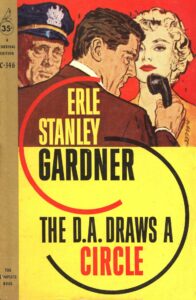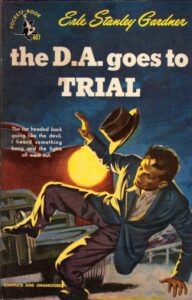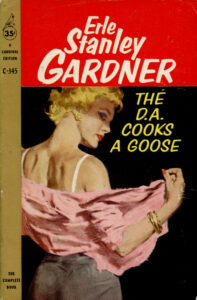Erle Stanley Gardner was in a quandary. Even something of a snit. The year was 1936, and as crime writer/critic Dorothy B. Hughes recalls in her 1978 biography, Erle Stanley Gardner: The Case of the Real Perry Mason, Gardner was seriously entertaining the notion of phasing out Perry Mason as a protagonist.
By then, he’d already published nine novels featuring that Los Angeles criminal defense attorney; his younger secretary with the “perfect” legs, Della Street; and Paul Drake, the droop-shouldered private eye whose 24-hour investigative agency never seemed to find time for clients other than Mason. The books had sold well, allowing Gardner to end his own marginally satisfying legal career and become a full-time—and remarkably prolific—author. Hollywood had further promoted the series, with Warner Bros. adapting six Mason yarns for the silver screen in half as many years. However, Warners had recently decided not to renew its option on the character (its last Mason picture, The Case of the Stuttering Bishop, would be released during the summer of 1937), and Gardner had begun to quarrel with his publisher over the text and titles of his novels. In the midst of all this, explains Hughes, he was losing faith in his shrewd and determined advocate. His solution: to send Mason off on a trip to China, never to return, and replace him with “a brand-new character, similar in many respects to Perry Mason, [only] a little more refined, a little less daring, a little more sophisticated.”
As we all know, of course, Gardner eventually recovered from his spasm of pique, changed his mind about sending Perry packing, and went on to feature him in more than 80 novels before passing away in 1970, at age 80. But the author didn’t meanwhile abandon his idea to develop another series lead. In 1937, he added to his writing responsibilities the creation of a new succession of books starring Douglas Selby, the scrappy district attorney for fictional Madison County, California.
Introduced in 1937’s The D.A. Calls It Murder, Selby faced off regularly against a colorful array of adversaries, including a buffoonish, headline-hunting chief of police and a smooth-talking but rascally L.A. attorney described as having “his finger in every unsavory pie in the county.” Early reviewers applauded this second Gardner line of books for boasting “plenty of action,” and greeted its star with great expectations; in its critique of The D.A. Calls It Murder, The New York Times observed that Selby, “like Mason, is a fighter who can take it as well as he can dish it out.” Doug Selby was upright and earnest, distinctly human and—unlike Mason—fallible. Yet he featured in a mere nine novels before vanishing (not in a China-bound ship). That was unfortunate, because while those stories never enjoyed the same level of reader enthusiasm Perry Mason’s escapades did, and were neither as humorous nor as briskly paced as another series Gardner launched in 1939, built around mismatched L.A. gumshoes Bertha Cool and Donald Lam, they certainly offered plenty in the way of knotty plots, ill-starred suspects, and razzle-dazzle legal shenanigans.
* * *
When we first meet Doug Selby, he’s just been elected to lead the District Attorney’s Office in Madison City, a 90-year-old former cattle-ranching and mining community—still dependent on agriculture for much of its prosperity—located roughly 70 miles outside of L.A. Madison City is also the governmental seat of Madison County (based on Southern California’s Ventura County, where Gardner lived and practiced law for many years, while concocting fiction at night). Selby, described as “a handsome young man with curly hair, a devil-may-care glint in his penetrating eyes, and a forceful, though shapely, mouth,” won his new position after “a bitterly contested battle” against an unscrupulous, deeply entrenched incumbent D.A. named Sam Roper. Selby had run on a reform ticket together with the now county sheriff, Rex Brandon, a leathery-faced cattleman a quarter-century Selby’s senior, whose legs are “bowed from years spent on horseback” and who boasts “a keen knowledge of human nature.”
Selby figures that winning their campaign was the hardest thing the pair faced, and that thereafter they can get down to the business of administering evenhanded justice. But Brandon, who grew up in the area, warns Selby that their political opponents haven’t gone away, and that they are destined to face new challenges from petty grifters and scoundrels moving in from the City of Angels. “[T]he main thing is,” he says, “that we’ve got to watch our step, particularly at the start. If we make just one minor mistake, they’ll hoot us out of office.”
Crooks and out-of-power malcontents aren’t the only ones likely to make their lives tough. The Blade, one of two local newspapers—closely allied with Sam Roper—demonstrates from the outset that it will take every opportunity to castigate Selby as incompetent, credulous, and callow. Fortunately, he and Brandon can count on better treatment from The Madison County Clarion and its rising-star reporter, Sylvia Martin, who’s ready to lend Selby aid and feed him information in exchange for the inside line on his criminal investigations.
Like so many other mystery-fictionists of his era, Gardner was stingy with his characters’ descriptions and back-stories. For instance, we learn little about Selby’s history over nine books, except that he won a boxing championship in college. It’s not until halfway through the series that Sheriff Brandon’s sturdy, no-nonsense wife (never given a forename) receives better than a passing mention. And the author’s portrait of Sylvia Martin never extends much beyond her being an attractive, “trimly efficient,” poised, and “spunky” young woman gifted with “a nose for sleuthing.” To the best of my recollection, we’re never told so much as that journalist’s hair color, though the cover illustration on a 1946 Canadian paperback edition of The D.A. Goes to Trial—the fourth entry in this series—imagined her as a blonde.
One other thing we learn about Sylvia Martin: her relationship with Selby has the potential to become more than professional. They wind up dining together, traveling together in fervid pursuit of clues, and sharing small intimacies. Yet the workaholic Sylvia—like Della Street with a press pass—is reluctant to get closer to the man she works so closely with and clearly admires.
* * *
The American novelist, literary critic, and Atlantic Monthly editor William Dean Howells brooked no patience for “exaggerated” fiction designed to startle readers rather than make them “think and feel.” He wrote disparagingly of stories with “a complicated plot, spiced with perils, surprises and suspenses.” Which suggests he would have been apoplectic over Gardner’s fiction, for it was distinguished by nothing so prominently as plot convolutions, bombshell revelations, and storytelling velocity.
Take, for example, The D.A. Calls It Murder. It finds Selby and Brandon investigating a suspicious hotel death: The Reverend Charles Brower has perished in his room, ostensibly from an overdose of sleeping pills and a weak “ticker.” But as it turns out, the deceased wasn’t who he claimed to be, and his demise was well short of accidental. What’s more, Brower left behind an envelope containing a mysterious $5,000, along with newspaper clippings about a movie starlet (who just happened to be hiding out in the same hotel) and a lawsuit over the proper disposal of a fat estate. While The Blade demands expeditious results, Selby and Brandon are confronted with the puzzle of a poisoned watchdog, an evidently impossible set of photographs, and an interview with a dead man.
In another writer’s hands, these assorted leads and red herrings might have resulted in a mess. But Gardner was deft at juggling such volatile ingredients, even if—as in this case—leaps of faith must be executed and a confession heard in order to make sense of them all. One interesting twist here, to be echoed in later series entries, is to see Selby periodically caught flat-footed, his trusting nature exploited by folks with nefarious agendas. There are never doubts that Selby will triumph in the end, but unlike the more confident, imperturbable Perry Mason, he often depends on the intervention of supporters such as Sylvia Martin to ensure that happening.
The Selby tales became no less intricately structured or propulsive as their numbers multiplied. Book two, The D.A. Holds a Candle (1938), has the district attorney and sheriff dealing, in part, with the auto camp death of a hitchhiker. The man appears to have succumbed to carbon monoxide poisoning, caused by a faulty gas heater left running in his room on a cold night. However, there are some peculiar aspects to this tragedy, including that the deceased was huddled behind a dresser with a gun in his hand and a prolix note indicating he was lying in wait for somebody else—somebody the note insists “deserved to die.” Did this wayfarer’s presumably accidental demise prevent another person’s murder? Meanwhile, there’s a gambling racket to uncover, a hit-and-run incident that requires probing, and a pompous capitalist—the father of Inez Stapleton, Sylvia Martin’s rival for Selby’s affections—to mollify. As is so frequently true in these stories, the cases Selby, Brandon, and Sylvia Martin tackle wind up linking together in unpredictable ways.
In 1939’s The D.A. Draws a Circle, a resident in one of Madison City’s pricier corners, Rita Artrim, makes a late-night phone call to the police, saying she’s spotted a naked prowler scurrying along the edge of a deep, narrow ravine adjacent to her property. That same night, a pistol shot is heard in the area. The city’s police chief, Otto Larkin—a paunchy, thickheaded “political stooge” in his early 30s who’s wont to take credit for successes that aren’t his and eschews blame when things go awry—dismisses the alleged gunfire as insignificant. But upon investigation, the unclothed corpse of a man is discovered in the canyon. He’s been shot twice, with both bullets fired from different guns yet having traveled through the selfsame hole. Equally odd is evidence showing one bullet was fired directly into the victim’s nude flesh, while the other passed initially through fabric. As if all of that weren’t enough to test Selby’s deductive skills, throw in an elusive bail-jumper, strange doings in the Antrim household, a possible insurance scam, and the disappearance of Rita Antrim’s father-in-law—reportedly debilitated by an accident that’s also said to have left him with amnesia.
The D.A. Draws a Circle adds to this series’ mix of regular players one Alphonse Baker Carr, a tall, suave, big-time criminal lawyer from L.A. in his mid-50s, known to his customarily questionable clients as “Old A.B.C.” He claims to have taken up residence in Madison City for the purpose of retirement, but never quite gets around to trimming his practice. Appearing in all but one of the remaining six Selby books, Carr is a richly comic figure with a malleable code of ethics: he’ll do pretty much anything to get his clients off. Just as prone as Perry Mason is to capitalize on legal loopholes, Carr is very much like the dark side of Gardner’s most famous attorney. The more straightforward Selby appreciates Carr as a legal “artist,” but doesn’t trust him. With good reason.
Being among the best of these yarns, it’s understandable that The D.A. Draws a Circle was adapted (loosely) into a Doug Selby TV pilot. Gardner had been trying for years to launch such a show, but the two-hour, 1971 NBC film retitled They Call It Murder was as close as he got. Scripted by Have Gun–Will Travel creator Sam Rolfe, the pilot starred Jim Hutton (later to deliver a superior performance in the 1975–1976 mystery drama Ellery Queen), with Lloyd Bochner as a particularly oleaginous Carr. Sadly, Gardner died before They Call It Murder premiered, and NBC declined to turn it into a weekly program.
* * *
By 1939, Gardner had his writing hands full. Not only was he churning out two Perry Mason books per annum, but he’d also just published—under the pseudonym A.A. Fair—The Bigger They Come, the first of what would ultimately be 30 Lam and Cool novels.
Nonetheless, he continued penning Doug Selby books, if at a slightly reduced clip. 1940 saw the release of The D.A. Goes to Trial, which involves a dead hobo of dubious identity; an absconding wife and a suspect divorce; ill-matched fingerprints and embezzlement; plus the return of Inez Stapleton, who’s won a legal degree in hopes that Selby will take her more seriously. In The D.A. Cooks a Goose (1942)—another high-water mark for this series—we’re given a no-less-bewildering amalgam of plot elements, among them a hit-and-run accident that injured a woman and killed her baby; another infant, found at a bus depot; a supposedly confirmed bachelor with a secret spouse and an unexpected fortune; and a too-convenient last will and testament. Another two years passed before the debut of The D.A. Calls a Turn (1944). It sees Selby and Brandon responding to a desperate call from a man who says he’s drunk and in possession of a stolen vehicle. The pair arrive on the scene too late, though: the man is killed in a traffic accident, leaving our heroes to figure out why he was dressed as a vagrant, yet had professionally manicured fingernails and handmade shoes. It doesn’t take long for the corpse to be identified as that of a chain store grocer, and for an autopsy to reveal that he actually perished before the car crash. A long-ago prison riot, a conniving wife, and another instance of memory loss all heighten the mystery.
While their plot lines ripple with issues of jurisprudence, the Selby books are as much traditional detective stories as they are legal mysteries. The D.A. continually demonstrates the depths of his deductive acumen—and often gambles his reputation on smart guesswork. Also on display in these tales is Gardner’s appreciation for California’s rural reaches and the simpler ways of its people, all of which are endangered by spreading cities. He writes of citrus-tree growers combating frost with “smudge smoke which lay as a black pall over the community”; of parched November days when “hillsides [were] seamed and fissured with heat cracks”; and of “the hoarse bark of tractors as ranchers, bundled against the cold, pulled plows across the fertile soil.” Many Selby yarns were syndicated in The Country Gentleman, an American agricultural magazine, and it’s easy to understand their appeal to that audience.
Gardner wanted his Perry Mason novels to remain as timeless as possible, so he minimized references to historical events. On the other hand, he sent his “brainy little runt” of a series shamus, Donald Lam, off to fight the Japanese during World War II; and in The D.A. Breaks a Seal (1946), we learn Doug Selby has resigned his office to enlist in the Army, working in counterespionage. But for this story, Major Selby is on a five-day furlough and back in Madison City, just in time to help tackle the puzzle of a lone hotel guest who was poisoned after having two breakfasts sent to his room, and aid Inez Stapleton in contesting a dead woman’s will.
The concluding pair of books in this line—best read in order of their publication—find Selby out of uniform again and returned to the District Attorney’s Office, after a “nasty fight” that nearly led to his replacement’s recall. The D.A. Takes a Chance (1948) embroils Gardner’s protagonist in the bizarre story of a house party gone wrong, which may or may not have resulted in shots being fired, but was definitely followed by the sequestering of a fetching “Hollywood party girl”…who is soon after murdered, allegedly by a carving knife bearing Sheriff Brandon’s prints. A.B. Carr’s manipulation of people and alibis here almost proves his undoing, and desperate measures are required to save him from criminal prosecution and disbarment. Municipal corruption forms a background to this story, reminding readers that Selby and Brandon must occasionally walk a delicate political path to maintain their jobs.
Finally, in The D.A. Breaks an Egg (1949), we discover The Blade under new but equally hostile management, ready to denounce Selby and Brandon over their handling of an inquiry that involves a stolen car, a bilked gambler, a corpse in a park, a baffling burglary, a female private eye who “specializes on cases involving playboys,” and a murder victim who turns out to be very much alive. Once more, Carr’s maneuverings leave him precariously positioned, but there’s every chance he’ll escape indictment and remain free to torment the D.A. and the sheriff, as well as newshound Sylvia Martin, who by the end of this book appears to have captured Selby’s romantic notice. (It’s about time!)
So why, when there still seemed many inviting avenues down which this series might travel, did Erle Stanley Gardner cut it off at nine books? Jeffrey Marks, the publisher at Crippen & Landru, and author of an as-yet-unpublished Gardner biography, suggests Gardner was too busy with his Mason series, his Cool and Lam books, a weekday Mason radio drama, and other endeavors to spare time for Selby. “The gap between each book,” Marks says, had grown to “18 months, which displeased Gardner, since he couldn’t remember the characters and details that long. Finally, he just gave up on [Selby], contenting himself with two best-selling series.”
The result? Seven decades after Doug Selby’s last outing, Perry Mason is a household name. Cool and Lam are being rediscovered, thanks to publisher Hard Case Crime. And Selby is all but forgotten.


























